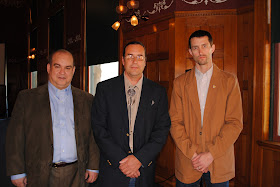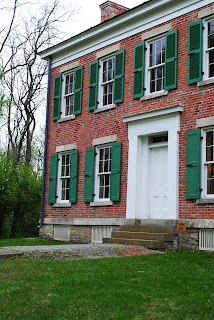At a
press conference on April 17, Todd Maxwell Pelfrey, executive director of the
History Center, offered a brief history of the life of Chief Richardville.
“Born in Kekionga (in what would become Fort Wayne)
in 1761, Chief Jean Baptiste de Richardville (know as Pinsiwa, “The Wildcat,”
in the Miami language) served as the Akima or Civil Chief of the Miami from
1814 until his death in 1841. His legacy and the legacy of his people
were secured through his implementation of a seemingly benign yet revolutionary
piece of treaty making, the establishment of fee-simple title to Miami
homelands throughout Indiana and construction of permanent residences for
tribal leaders on these lands. His home at 5705 Bluffton Road was
constructed in 1827, funded in part by the 1826 Treaty of Mississinewa, along
with eight other residences for his sub-chiefs throughout northern Indiana.
“Richardville’s descendants lived in the house
until 1908, when it passed into private hands. The History Center
purchased the house in 1991 and conducted a $360,000 restoration of the full
exterior and portions of the interior in 2002 and 2003. The home opened
for public tours in summer 2004 and today is the site of the Miami Indian
Heritage Days series held on the first Saturday of each month from May to
November.”
“The Chief Richardville House (Akima Pinsiwa
Awiiki) bears many noteworthy titles, including the only treaty house in the
nation, one of the oldest Native American structures in the country, the oldest
Greek Revival style house in the state, and the oldest structure in northeast
Indiana.”
George Ironstrack, of Miami (OH) University’s Myaamia Project, offered remarks about the historical significance of the
landmark designation.
“Historically,
Akima Awiiki - the Chief's lodge - sat at the heart of the village, physically
and emotionally. Important visitors were
always greeted at the edge of our village and then taken to the Akima Awiiki,
where they could be cared for and made to feel at home. The Akima Awiiki was where new friendships
were kindled and old friendships renewed.
It was where vital material goods were distributed to people, and where
both men and women gathered to discuss the past, present, and future of their
community. The Akima Awiiki was built,
maintained, and used to meet the needs of the people whom the akima served. A
leader’s home and his belongings were always at the “mercy” of his people. Good leaders, however, were compensated for
this obligation through the many gifts they received. As a result, the homes of great leaders often
reflected the regard with which they were held.
“As
the shape, size, and needs of our community changed, the Akima Awiiki changed
with it. Bent saplings, cattail mats,
and elm bark shifted to splits logs, hewn boards, and chinking, which in turn
shifted to brick, plaster, and planed wood.
But while the materials changed, the purpose of the Akima Awiiki remained
largely the same. The Akima Pinšiwa
Awiiki - Chief Richardville's house – occupies an important place in the
history of our development as a tribal nation.
In that wonderful home visitors were honored with great
hospitality. In it and around it our
community gathered to present their thoughts to their servant leader. And it was at that place that the wealth of
the community was distributed during treaty annuity payments.
“The
house also stands a symbol of our people's strategic attempts to resist land
loss and forced removal through peaceful negotiations. The nineteenth century was a confusing time
for my people, and it remains no less confusing for us today. The treaties we made with the United States
of America rapidly diminished my people's land base, in exchange we were
promised a secure, albeit smaller, homeland upon which to rebuild. These treaties also promised us the means to
rebuild: money, education, new infrastructure – like houses and farms, and
expertise – like blacksmiths, millers, and teachers.
“The
Akima Awiiiki stands then as a powerful symbol of both success and
failure. It was built in exchange for
land that we dearly loved, and it became one of the centers of our resistance
to forced removal – a resistance that ultimately and tragically failed. This home and the people who lived within it
witnessed a horrific fracturing of their community, which included land loss,
population decline, forced removal, cultural and language loss, and the
scattering of Myaamia people across the continent. This was a breaking that we were not supposed
to survive.
 | ||||||||||||
| Michael Galbraith, ARCH executive director, Daryl Baldwin and George Ironstrack at the press conference. |
“And
yet, here we are. Myaamia people still
call the Wabash River Valley home.
Myaamia people, my own family included, still call Fort Wayne home. And those who made that heart-wrenching
journey in 1846, rebuilt the nation that Pinšiwa and others strove to so hard
to maintain. Today, we still gather as a
people to celebrate our lives and to remember the difficult sacrifices made by
our ancestors and our beloved leaders, like Pinšiwa. The National Historic Landmark recognition of
the Akima Pinšiwa Awiiki is a great point of pride for all the people of the
Fort Wayne area, while our perspectives and experiences may differ, the story
of that great place belongs to all of us.”
Daryl Baldwin of the Myaamia Project also offered his
commentary on the importance of this landmark designation for the Miami.
“Over the years I have had several opportunities to visit akima awiiki ‘the
Chiefs House’. The house may symbolize history for many, but for some of us it
serves as a symbol of transition in an ongoing story of our survival as a
tribal nation. This survival story, which includes the historic events
associated with akima awiiki, is very relevant to our contemporary times. Just as Pinšiwa grappled with the challenges associated
with protecting our sovereignty, developing an economy, and educating our
youth, we still, to this day, continue building our community infrastructure to
support our future.
“We survive today as Myaamia People because of our distinctiveness.
We have a history, strong kinship ties, a belief in our leaders, and the desire
to pass on our language and culture to the next generation. These aspects of
our peoplehood are what made us a nation historically and continue to define us
today. Myaamia tribal leaders have long understood this and Pinšiwa acknowledged this reality in 1832
during a treaty negotiation when he stated:
“’We are governed by our own laws and subject to none
other.’”
“Pinšiwa was one of many who have and continue
to lead our nation today. From the times of Pakana
during the turn of the 19th century,
through the leadership of Pinšiwa, who brought us to a time of great hardship with an
unwanted removal west, and on to our present leader katakimaankwa ‘Chief
Gamble’, who with other current elected leaders carry out our nations work in
the Miami lands of Oklahoma. We have always been a people; a nation; a
sovereign. Today, the Miami Tribe of Oklahoma has 4,000 citizens with
populations concentrated in Oklahoma, Kansas and Indiana.
“When I see the house I am reminded of this ongoing story.
Like the stones in its
foundation, the house represents one stone in our nations
story. Small and insignificant by itself, but when put into the context of the
whole is a pillar in our nations work.
“The preservation of the Pinšiwa
awiiki helps us remember. For those of us who
live here in the footprints of our history, the house continues to be a place
of gathering, learning, and sharing. For those who live far away the house
helps us feel ‘home again’ in kiihkayonki. I am really pleased that my grandchildren will be able to
visit this Myaamia national landmark.”

No comments:
Post a Comment